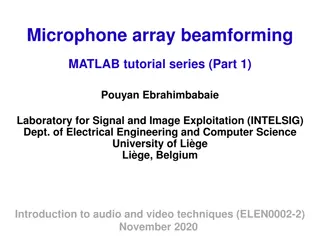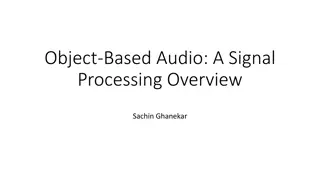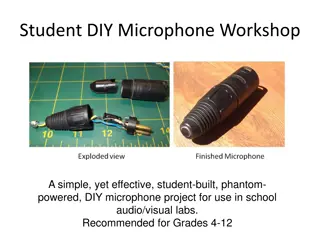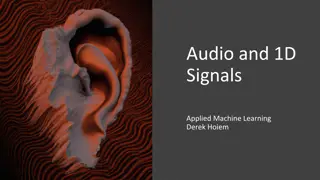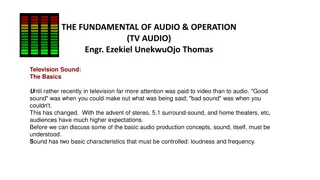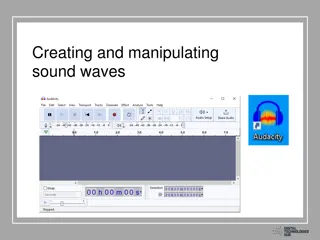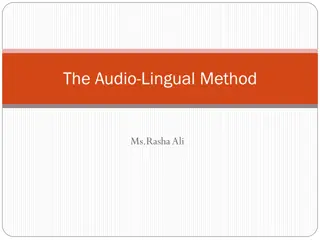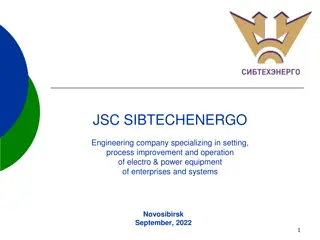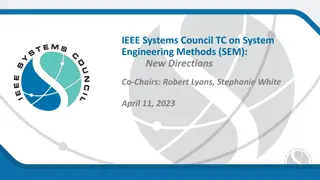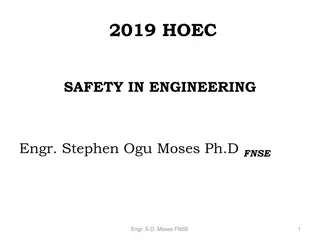Mastering Microphone Techniques for Audio Engineering
Explore the world of microphones in audio engineering, from different types like condenser and dynamic to major designs including handheld and studio microphones. Learn how to choose and use microphones correctly, control sound volume with portable mixers, and understand various microphone applications for EFP and on-location production.
Download Presentation

Please find below an Image/Link to download the presentation.
The content on the website is provided AS IS for your information and personal use only. It may not be sold, licensed, or shared on other websites without obtaining consent from the author. Download presentation by click this link. If you encounter any issues during the download, it is possible that the publisher has removed the file from their server.
E N D
Presentation Transcript
AUDIO ENGINEERING OPERATION AND MAINTENANCE DAY 3.
CHOOSING AND USING MICROPHONE CORRECTLY
PRESENTED BY ENGR. EZEKIEL UNEKWUOJO THOMAS.
THE MICROPHONE The first step in getting the sound of someone s voice into your video or film is the Microphone. A microphone is an acoustic to Electric transducer or sensor that converts sound energy into an electrical energy. Different types of microphone are available Electret capsule: Electrostatic- Condenser. Ribbon: Dynamic- Moving coil Cardioid: heart-shape. Hyper-cardioid Shotgun microphone
In the more critical EFP, the volume of incoming sounds is usually controlled by a portable mixer.
Microphones Major Microphone Designs There are six common microphone designs: hand held -- the type held by on-camera talent or used for on-location interviews personal mic (lavaliere / clip-on mic) -- Whether hung from a cord around the neck (lavaliere) or clipped to clothing, these are all referred to as personal mics.
shotgun -- used for on-location production to pick up sounds a moderate distance from the camera
boundary effect microphone -- also called PZ or PZM mics These rely primarily on reflected sounds from a hard surface such as a tabletop contact mics -- which pick up sound by being in direct physical contact with the sound source. These mics are generally mounted on musical instruments.
studio microphones -- the largest category of microphone. These include a number of application designs that we'll discuss.
These six categories include different transducer types, or approaches to converting sound waves into electrical energy. In this class we'll discuss the most popular types of mics and their characteristics.
Dynamic Microphones The dynamic mic (also called a moving-coil microphone) is considered the most rugged professional microphone.
When sound waves hit the diaphragm they move the coil of wire within the magnetic field. As a result, a small electrical current is generated that corresponds to the original sound waves. This signal must be amplified thousands of times.
When small size, optimum sensitivity, and the best quality are all prime considerations, another type of mic, the condenser mic, is often preferred.
Condenser microphones (also called capacitor or electret condenser mics) are capable of top-notch audio quality. As shown above, they can be made so small that they are almost invisible. (But, the smaller they are, the more expensive they tend to be!)
Condenser mics aren't as rugged as dynamic mics, and problems can result when they are used in adverse weather conditions.
The mics work on the principle that governs an electric condenser or capacitor. An ultra-thin metal diaphragm is stretched tightly above a piece of flat metal or ceramic. In most condenser mics a power source maintains an electrical charge between the elements.
The pre-amp can be located within the microphone housing or in an outboard electronic pack. Although most pre- amps output an analog signal, some of the newer models immediately convert the output to digital.
Because they require a pre-amp, this means that, unlike the dynamic mics discussed earlier, most condenser mics require a source of power, either from an AC (standard Alternating Current) electrical power supply or from batteries. An AC power supply for a condenser mic is sometimes built into an audio mixer or audio board. This is referred to as a phantom power supply.
When this type of power supply is used, the mic cord ends up serving two functions: it delivers the signal from the mic to the mixer and it carries power from the mixer to the pre-amp of the condenser mic. Some camcorder instructions recommend condenser mics because the pre-amp provides a high enough audio level to reduce undesirable system noise.
Of course, using batteries to power the pre-amp of the condenser mic is more convenient -- you don't have to use a special mixer or audio board connected to an electrical power source. But battery-powered condenser mics introduce a problem of their own: at the end of their life cycle the batteries can go out without warning.
To get around any unexpected problems, especially on important productions, two miniature condenser mics are often used together. If one mic goes out, the other can immediately be switched on. This double microphone technique is called dual redundancy.


